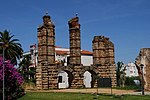National Museum of Roman Art
1838 establishments in SpainCultural tourism in SpainMuseums established in 1838Museums in ExtremaduraMuseums of ancient Rome in Spain ... and 1 more
National museums of Spain

The National Museum of Roman Art (Spanish: Museo Nacional de Arte Romano; MNAR) is an archaeology museum located in Mérida, Spain. Devoted to Roman art, it exhibits extensive material from the archaeological ensemble of Mérida (the Roman colony of Augusta Emerita), one of the largest and most extensive archaeological sites in Spain, registered as UNESCO World Heritage Site in 1993.
Excerpt from the Wikipedia article National Museum of Roman Art (License: CC BY-SA 3.0, Authors, Images).National Museum of Roman Art
Travesía del Museo, Merida San Antonio
Geographical coordinates (GPS) Address Nearby Places Show on map
Geographical coordinates (GPS)
| Latitude | Longitude |
|---|---|
| N 38.917306111111 ° | E -6.3398611111111 ° |
Address
Museo Nacional de Arte Romano
Travesía del Museo
06800 Merida, San Antonio
Extremadura, Spain
Open on Google Maps










